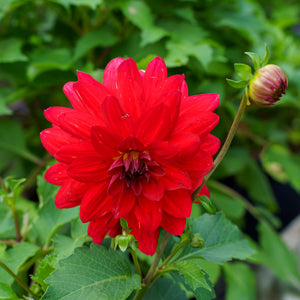The Dahlia Guide
Dahlias are stunning flowering plants treasured for their bold blooms and incredible range of colors, forms, and sizes. Blooming from midsummer to frost, these vibrant perennials (often grown as annuals in colder regions) are a staple in cutting gardens and make standout additions to sunny borders and container displays. With their lush foliage and striking flowers, dahlias offer continuous color and visual drama throughout the growing season.
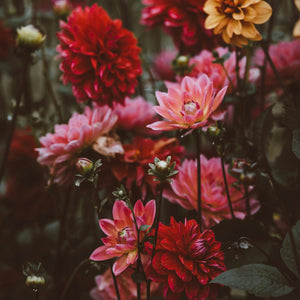
About
Dahlias are tuberous-rooted perennials native to Mexico and Central America. They belong to the Asteraceae family and have been extensively hybridized, resulting in thousands of cultivars with flower forms ranging from delicate singles to dramatic pompons, cactus, and dinner-plate varieties.
Popular cultivars include the rich red Dahlia 'Bishop of Llandaff' with dark foliage, the creamy white Dahlia 'Playa Blanca', and the moody, velvety Dahlia 'Karma Chocolate'. The 'Mystic' series, such as 'Mystic Spirit', 'Mystic Fantasy', and 'Mystic Illusion', is known for its finely cut dark foliage and vivid single blooms. Additional favorites include 'Purple Gem', 'Bishop of Auckland', 'Karma Serena', and 'Gold Crown', all bringing unique color, texture, and character to garden beds.
Dahlias are typically grown as annuals in Zones 3–7 and as perennials in Zones 8–11. However, gardeners in cooler climates can lift and store the tubers over winter, allowing these beautiful plants to return year after year.
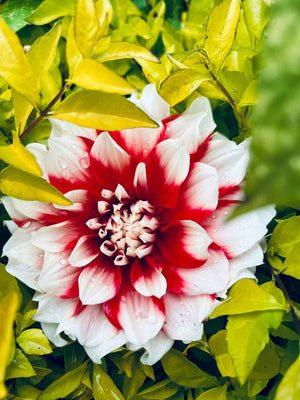
PLANTING
Dahlias are grown from tubers, which require warmth and well-drained soil to establish and bloom successfully. Timing and proper planting techniques are key:
- USDA Hardiness Zones: Perennial in Zones 8–11; grown as annuals or lifted for winter storage in Zones 3–7.
- Soil: Loose, well-draining soil enriched with compost or organic matter. Avoid soggy areas that may cause tuber rot.
- Sunlight: Full sun (at least 6 hours daily) is essential for strong growth and flowering.
- Watering: Water deeply but infrequently after shoots emerge. Avoid watering before growth appears to prevent tuber rot.
- Spacing: Space plants 12–24 inches apart depending on variety and mature size.
- Planting Time: Plant tubers outdoors after the last frost when soil temperature reaches 60°F.
To plant, dig a hole 4–6 inches deep, place the tuber horizontally with the eye (growing point) facing up, and cover with soil. Wait to water until green shoots appear.
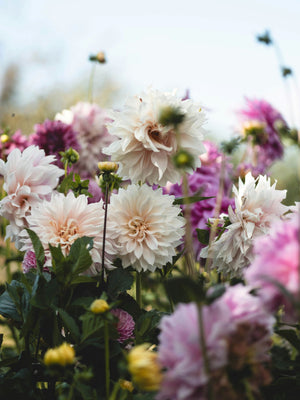
CARE
Dahlias thrive with regular attention and reward gardeners with a continuous display of vibrant blooms throughout the season:
- Watering: Water deeply 1–2 times per week once growth begins, especially during dry spells.
- Fertilizing: Use a low-nitrogen fertilizer every 3–4 weeks after shoots appear. Excess nitrogen encourages foliage over flowers.
- Staking: Tall or heavy-flowering varieties benefit from support. Install stakes at planting time to avoid damaging tubers later.
- Deadheading: Remove spent blooms regularly to promote continuous flowering and prevent seed formation.
- Pests & Diseases: Watch for aphids, spider mites, and powdery mildew. Treat early with insecticidal soap or neem oil as needed.
- Winter Care: In cold climates, lift tubers after the first frost, clean and dry them, then store in a cool, dry, frost-free place until spring.
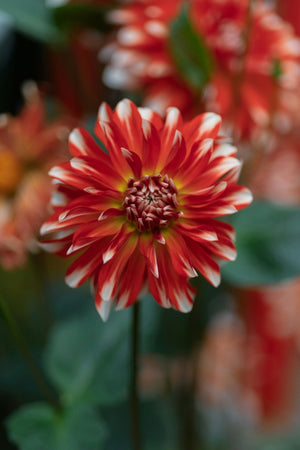
HOW TO USE
Dahlias add drama, color, and texture to nearly any sunny space. Their versatility makes them ideal for various uses in garden design:
- Cut Flower Gardens: A top choice for floral arrangements thanks to their long-lasting blooms and wide color range.
- Mixed Borders: Combine with rudbeckia, salvia, cosmos, and ornamental grasses for a dynamic summer-fall display.
- Containers: Compact varieties like those in the 'Mystic' series work beautifully in pots for patios and balconies.
- Pollinator Gardens: Single-flowered types provide easy access to nectar for bees and butterflies.
- Seasonal Bedding: Mass plant for a bold seasonal display in front yards, public gardens, or formal borders.
Pair dahlias with sun-loving perennials like coreopsis, agastache, and echinacea, or let them shine alongside annuals like zinnias, marigolds, and snapdragons.
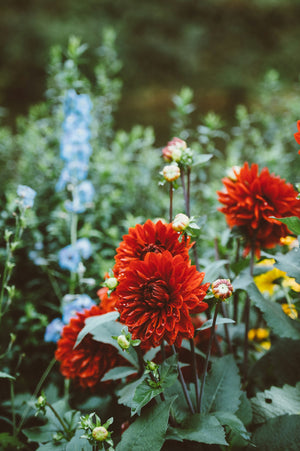
COMMON QUESTIONS
- Are dahlias perennials? Yes, dahlias are perennials in Zones 8–11. In colder climates, they’re grown as annuals unless tubers are lifted and stored.
- How to plant dahlia tubers? Place tubers 4–6 inches deep in well-draining soil after the last frost, with the eye facing upward.
- When to plant dahlias? Plant after the last frost in spring, once the soil has warmed to at least 60°F.
- Do deer eat dahlias? Unfortunately, yes. Dahlias are not deer-resistant and may be browsed by deer.
- How to plant dahlias? Choose a sunny, well-drained site. Space tubers appropriately, plant with eyes up, and delay watering until growth appears.
- Are dahlias deer resistant? No. Dahlias are frequently eaten by deer and should be protected in deer-prone areas.
- Are dahlias toxic to cats? Yes, dahlias are considered mildly toxic to cats and may cause mild gastrointestinal upset if ingested.
- Are dahlias toxic to dogs? Yes, dahlias are also mildly toxic to dogs.
- When do dahlias bloom? Dahlias bloom from mid-summer until the first frost.
- Are dahlias annuals or perennials? They are perennials in warm climates but treated as annuals in cold regions unless overwintered.
- Do dahlias come back every year? In Zones 8–11, they can return. In colder zones, tubers must be dug up and stored over winter.
- How to deadhead dahlias? Snip off spent blooms just above a leaf node to encourage new buds and extend the blooming period.
Conclusion
Dahlias are a breathtaking addition to gardens of all sizes, offering a spectacular range of color, form, and texture. Whether you’re growing 'Bishop of Canterbury', 'Mystic Haze', or 'Karma Lagoon', there’s a dahlia to suit every style and space. With proper planting, care, and winter storage, these stunning plants can provide years of beauty and joy.
The Dahlia Collection
Sold Out
Sold Out
Sold Out
Sold Out




